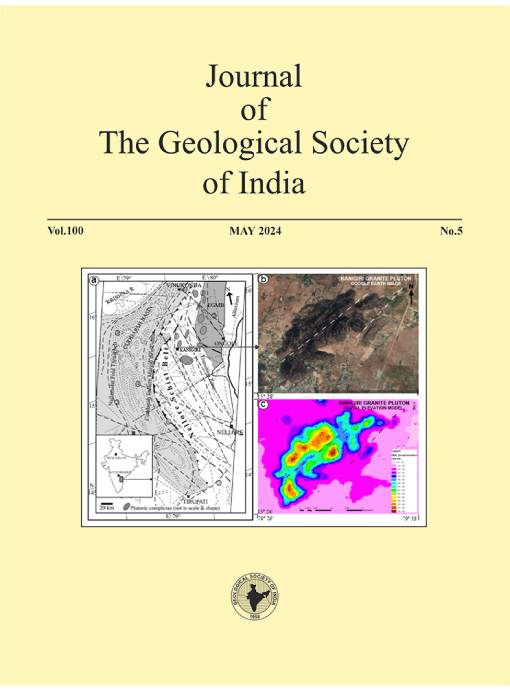Landslides: Unfolding Slope Disasters in Hilly Terrains
DOI:
https://doi.org/10.17491/jgsi/2024/173861Keywords:
No Keywords.Abstract
No Abstract.
Downloads
Metrics
Issue
Section
Downloads
Published
How to Cite
References
Agrawal, N. and Dixit, J. (2022) Assessment of landslide susceptibility for Meghalaya (India) using bivariate (frequency ratio and Shannon entropy) and multi-criteria decision analysis (AHP and fuzzy-AHP) models. All Earth, v.34(1), pp.179-201. https://doi.org/10.1080/27669645.2022.2101256
Alsabhan, A.H., Singh, K., Sharma, A., Alam, S., Pandey, D.D., Rahman, S.A.S. and Munshi, F.M. (2022). Landslide susceptibility assessment in the Himalayan range based along Kasauli–Parwanoo road corridor using weight of evidence, information value, and frequency ratio. Jour. King Saud Univ.-Sci., v.34(2). https://doi.org/10.1016/j.jksus.2021.101759
Badola, S., Mishra, V.N. and Parkash, S. (2023b) Landslide susceptibility mapping using XGBoost machine learning method. In: 2023 International Conference on Machine Intelligence for GeoAnalytics and Remote Sensing (MIGARS) (Vol.1, pp.1-4). IEEE. https://doi.org/10.1109/MIGARS57353.2023.10064496
Badola, S., Mishra, V.N., Parkash, S. and Pandey, M. (2023a) Rule-based fuzzy inference system for landslide susceptibility mapping along national highway 7 in Garhwal Himalayas, India. Quaternary Sci. Advan., https://doi.org/10.1016/j.qsa.2023.100093
Baum, R.L. and Godt, J.W. (2010) Early warning of rainfall-induced shallow landslides and debris flows in the USA. Landslides, v..7, pp.259-272. https://doi.org/10.1007/s10346-009-0177-0
Bhatt, B.P., Awasthi, K.D., Heyojoo, B.P., Silwal, T. and Kafle, G. (2013) Using geographic information system and analytical hierarchy process in landslide hazard zonation. Appl. Ecol. Environ. Sci., v.1(2), pp. 14-22.
Cruden, D.M. and Varnes, D.J. (1993) Landslide types and processes: Landslide Investigation and Mitigation. Transportation Research Board, US National Academy of Sciences, pp.1-60.
Es-smairi, A., Elmoutchou, B., Mir, R.A., Touhami, A.E.O. and Namous, M. (2023) Delineation of landslide susceptible zones using Frequency Ratio (FR) and Shannon Entropy (SE) models in northern Rif, Morocco. Geosyst. Geoenviron., v.2(4). https://doi.org/10.1016/j.geogeo.2023.100195
Fell, R. (1994) Landslide Risk Assessment and Acceptable Risk. Canadian Geotech. Jour., v.31(2), pp.261–272.https://doi.org/10.1139/t94-031
Havenith, H.B., Torgoev, A., Braun, A., Schlögel, R. and Micu, M. (2016) A new classification of earthquake-induced landslide event sizes based on seismotectonic, topographic, climatic and geologic factors. Geoenvironmental Disasters, v.3(1), pp.1-24.https://doi.org/10.1186/s40677-016-0041-1
Hungr, O., Leroueil, S. and Picarelli, L. (2014) The Varnes classification of landslide types, an update. Landslides, v.11, pp.167-194. https://doi.org/10.1007/s10346-013-0436-y
Katsura, S.Y., Kosugi, K.I., Mizutani, T., Okunaka, S. and Mizuyama, T. (2008) Effects of bedrock groundwater on spatial and temporal variations in soil mantle groundwater in a steep granitic headwater catchment. Water Resour. Res., v.44(9).https://doi.org/10.1029/2007WR006610
NDMA (2019) National Landslide Risk Management Strategy. September 2019. pp.1-48.
OFDA/CRED (2018) International Disaster Database. Brussels: Université Catholique de Louvain. www.emdat.be. Accessed 9 August, 2018
Parkash, Surya (2020) Training Module on Comprehensive Landslides Risk Management, National Institute of Disaster Management, New Delhi, 335p.
Parkash, Surya (2021) Lessons Learned from Landslides of Socio-economic and Environmental Significance in India, a Chapter in the book by Alcantara Ayala et al. (Eds.), Progress in Landslide Research and Technology, v.1(2), pp.309-315, https://doi.org/10.1007/978-3-031-18471-0_23
Parkash, Surya (2022) Archival Records of Socio-economically and Environmentally Significant Landslides in India”, IPL (International Programme on Landslides) Project-233 Documentation report published by NIDM, New Delhi, 296p.
Rodriguez, C.E., Bommer, J.J. and Chandler, R.J. (1999). Earthquake-induced landslides: 1980–1997. Soil Dynamics and Earthq. Eng., v.18(5), pp.325-346. https://doi.org/10.1016/S0267-7261(99)00012-3
Singh, R. and Parkash, S. (2019) Need of National Landslide Risk Management Strategy for Reducing Landslide risk in India. Jour. Disaster & Development, v.8(1&2), pp.44-64.

 Surya Parkash
Surya Parkash






